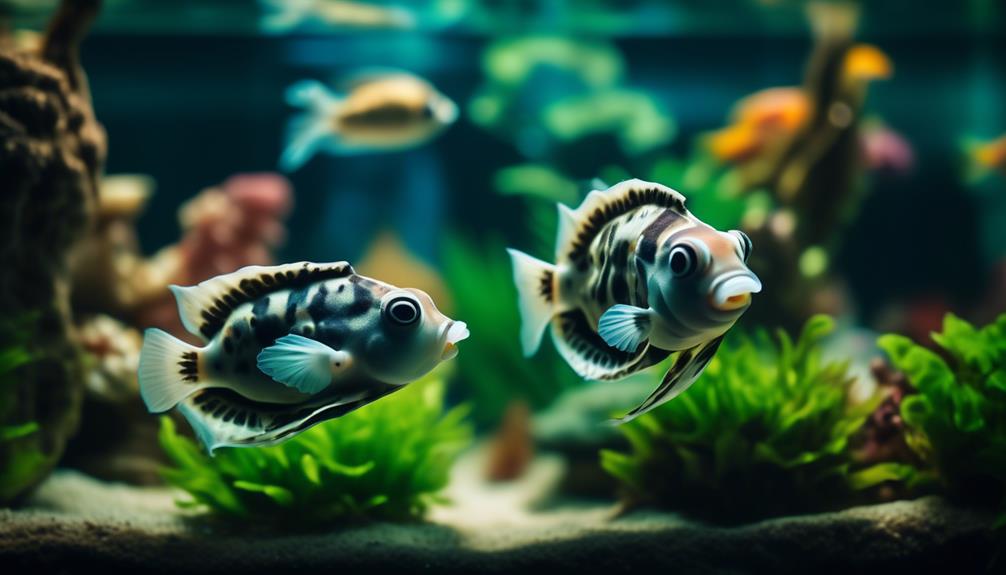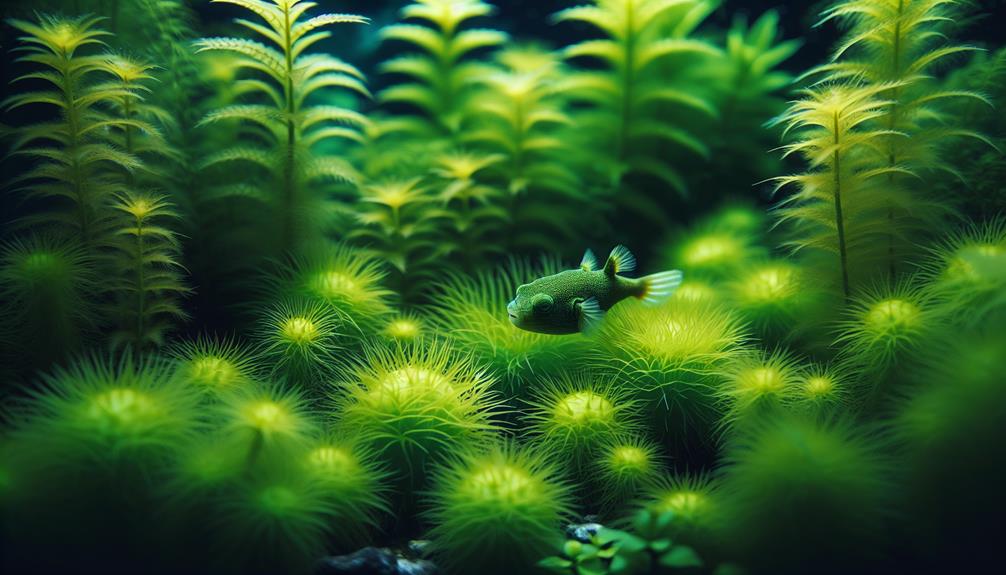Welcome to the enchanting realm of pea puffers, where these diminutive yet remarkable creatures reign supreme. Found in the freshwater habitats of southwestern India, these tiny pufferfish species have captured the attention of fish enthusiasts worldwide. With their unique characteristics and behavior, they leave us in awe of their abilities.
In this article, we will embark on a journey of discovery, exploring the intriguing world of pea puffers. From understanding their care requirements to unraveling the mysteries behind their puffing behavior, we will uncover the secrets that make these tiny beings so mighty.
So, brace yourself for an adventure into the captivating world of pea puffers, where surprises await at every turn.
Key Takeaways
- Pea puffers are the smallest pufferfish in the world, growing only to one inch long.
- They are native to freshwater environments in the southwestern tip of India.
- Pea puffers are best kept in a species-only aquarium due to their aggressive and territorial nature.
- They require a well-balanced, densely planted tank with stable tropical temperatures and pH levels, as well as a diet consisting of frozen and live foods.
Description and Care of Pea Puffers
Carinotetraodon travancoricus, commonly known as the Pea Puffer, is a minuscule freshwater pufferfish originating from the southwestern tip of India. These tiny pufferfish grow to only one inch in length and are commonly sold for $3 to $15 in local fish stores.
When selecting a pet Pea Puffer, it is important to choose a healthy fish with a nicely rounded belly. Breeding Pea Puffers can be challenging, as they require specific water conditions and a well-established aquarium.
Common health issues in pea puffers include bacterial infections, parasitic infestations, and swim bladder problems. Providing a well-maintained tank, suitable diet, and regular monitoring of water parameters are crucial for their overall well-being.
Puffing Behavior and Handling
Pea puffers, also known as Carinotetraodon travancoricus, exhibit fascinating puffing behavior as a defensive mechanism or for practice. When threatened, these tiny pufferfish have the ability to puff up by rapidly ingesting water, increasing their size and deterring potential predators. This defensive behavior is crucial for their survival in the wild.
However, deliberately stressing out the puffer is not recommended as it can lead to unnecessary harm. When handling pea puffers, it is important to use a cup or small container for transportation to prevent accidental air intake, which can be harmful to their delicate respiratory system.
Additionally, tank maintenance plays a vital role in ensuring the well-being of pea puffers. Regular cleaning and water parameter monitoring are essential, as these puffers are known to be aggressive and territorial. Maintaining a well-balanced, densely planted tank provides cover and reduces aggression.
Tank Setup and Compatibility

When setting up a tank for pea puffers, it is important to consider their aggressive and territorial nature, as well as the need for a well-balanced and densely planted environment.
Pea puffers are best kept in a species-only aquarium to avoid aggression and fighting. Adding other fish or tank mates may result in stress and potential harm to the puffers.
Additionally, maintaining good water quality is crucial for the health of pea puffers. Regular water changes and monitoring of water parameters such as temperature and pH levels are necessary. A gentle filter with a slower flow rate is recommended to prevent stress.
It is also important to provide a well-balanced diet consisting of frozen and live foods to ensure proper nutrition.
Sexing and Identification of Pea Puffers
The process of determining the sex and identifying Carinotetraodon travancoricus, commonly known as pea puffers, involves observing and analyzing distinct physical characteristics and behaviors. Here are some key points to consider when sexing and identifying pea puffers:
- Pea puffer color variations: Males have deeper coloration and may exhibit more vibrant patterns. Females, on the other hand, have a yellow belly and may appear less colorful.
- Body shape: Males tend to have a slender body shape, while females have a plumper shape, especially when they are ready for breeding.
- Belly markings: Males may have a stripe or dot on their belly, which is absent in females.
- Behavior: Males are often more aggressive and territorial compared to females, especially during the breeding season.
Temperature, Ph, and Diet for Pea Puffers

After understanding the sexing and identification characteristics of pea puffers, it is crucial to focus on the optimal temperature, pH levels, and diet necessary for their well-being and thriving in captivity.
Pea puffers thrive in stable tropical temperatures ranging from 74 to 82°F. If the room temperature falls below this range or fluctuates, an aquarium heater is necessary to maintain the desired temperature.
pH levels of 6.5 to 8.4 are acceptable, but stability is more important than a specific number. A gentle filter with a slower flow rate should be used to prevent stress on the puffers.
In terms of diet, pea puffers are carnivores and primarily thrive on a diet of frozen and live foods. Frozen foods such as bloodworms and brine shrimp are ideal, and they may also accept Hikari Vibra Bites. Live snails or blackworms are excellent sources of food as well. It is important to offer a variety of frozen foods to ensure a well-rounded diet for the puffers.
When it comes to tank mates, it is recommended to keep pea puffers in a species-only aquarium as they are aggressive and territorial. Adding other fish or tank mates may result in aggression and fighting. A well-balanced, densely planted tank provides cover and reduces aggression among pea puffers.
Understanding and maintaining the appropriate temperature, pH levels, and diet is essential for the well-being and thriving of pea puffers in captivity.
Frequently Asked Questions
Can Pea Puffers Be Kept in a Community Tank With Other Fish?
Pea puffers should not be kept in a community tank with other fish due to their aggressive and territorial nature. It is recommended to keep them in a species-only aquarium to avoid aggression and fighting.
How Often Should I Clean the Tank for Pea Puffers?
How often should the tank for pea puffers be cleaned? Regular tank cleaning is essential for maintaining water quality and preventing the accumulation of waste. Best tank mates for pea puffers include snails and shrimp.
Do Pea Puffers Require Any Special Lighting in Their Tank?
Pea puffers do not have any special lighting requirements. However, providing a well-balanced, densely planted tank with adequate hiding spots will create a natural environment and reduce stress for these territorial fish.
Can Pea Puffers Be Kept in a Brackish Water Environment?
Pea puffers, Carinotetraodon travancoricus, are freshwater fish and cannot be kept in a brackish water environment. They are aggressive and territorial, so it is recommended to keep them in a species-only aquarium without tank mates.
What Is the Lifespan of a Pea Puffer in Captivity?
The lifespan of a pea puffer in captivity can vary, but on average, they live for about 3 to 5 years. Breeding pea puffers can be challenging due to their aggressive nature. Common health issues in pea puffers include swim bladder problems and bacterial infections.
Conclusion
In conclusion, the world of pea puffers is a captivating one, filled with unique characteristics and behaviors.
From their ability to puff up as a defense mechanism to their territorial nature and compatibility with other fish, these tiny creatures require careful attention and consideration in their care.
By understanding their specific needs in terms of temperature, pH levels, and diet, fish enthusiasts can ensure the optimum health and well-being of these fascinating creatures.
Dive into the intricacies of the pea puffer world and be amazed by their tiny but mighty presence.

